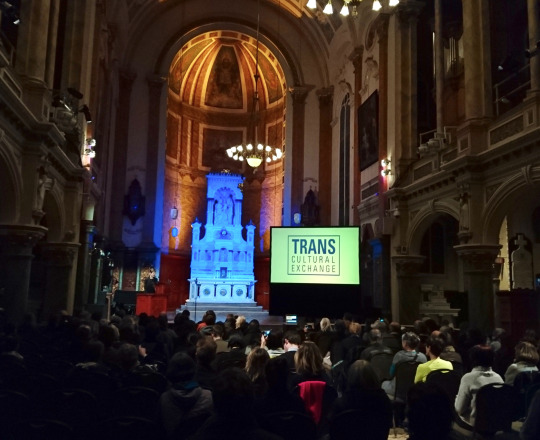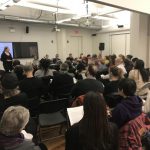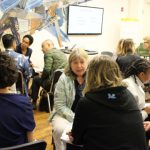Business of Art | TransCultural Exchange Conference Overview
“The more I travel, the more I see so many hybrid art forms as today’s norm." – Mary Sherman, Executive Director of TransCultural Exchange (TCE) and artist
In February, the TransCultural Exchange International Conference on Opportunities in the Arts: Exploring New Horizons took place in Québec City for the first time. Auberge International de Québec, the Maison de la Littérature, and the Morrin Centre hosted the three-day gathering of representatives of artist residencies, academics, and multidisciplinary artists from around the world who exchanged ideas, conducted workshops, and generously shared resources.
Helen Dennis, a mentor at NYFA’s Immigrant Artist Mentoring Program in New York, was also at the Conference. She shares her experience: “For me, the organizations that stood out were the ones that talked about the residencies in a context of the culture/regions they come from and the mutual partnership that they are looking for as an organization that supports artists. I’d never thought of heading to Taiwan before but the people I met from there were really inspiring and supportive of artists.”
TCE encourages participants to make friends and exchange notes in order to cover more ground. With three parallel events happening at the same time during the three-day Conference (as well as some portfolio reviews), this provides an ideal solution for artists who find it hard to decide where to go.

One of the biggest takeaways of the Conference was to “do your research” and be clear why you want to attend a residency abroad. It’s important to be sensitive and informed about the needs and realities of different countries.
For people looking to participate in artist residencies in China, Julia Lobyntseva, Residency Director of Red Gate Residency recommends: “From an organization’s perspective, we are looking for artists who are ready to embrace Chinese culture and life and be ready to explore it. It doesn’t matter for us if artists come to the Red Gate Residency with an exact goal, or whether they come for research or even just for relaxing and hanging out with a diverse art community in Beijing, but what really matters for us is when artists come to China without western standards and expectations. China is an amazing place, so different from everything else you have ever experienced, so the best way is to expect nothing and not to try to measure China, especially Beijing, in other country’s norms or limits.”
Mary Sherman, the Executive Director of Transcultural Exchange and a true supporter of the arts community, spoke with NYFA after the Conference.
NYFA: Why was Québec the chosen city for this past Conference?
Mary Sherman: We had been thinking about taking this Conference outside of our home base for a while, mainly at the advice of our advisory board. Then I got a call from the Québec City Business Destination, asking if we would bring the Conference to Québec City at the request of the artist Jeanne Landry who attended our 2009 and 2011 Conferences in Boston. As a result, she was invited to participate in a number of international exhibitions and residencies. These experiences so changed her life that she wanted the same for other Québécois artists.
This past Conference’s theme was Exploring New Horizons. I hoped by having it in Canada, some people who might not get visas to the U.S. could join us; and this was true. The speaker Antoine Abi Aad (from Lebanon) was finally able to attend. He was never granted a visa before, which was a real shame as he has a wonderful project creating new alphabets that combine Arabic, French, and English into pictograms of sorts.
NYFA: Some panels talked about residencies that focus on research, others about the needs of performing artists (who require large rehearsal spaces), like Tlacopac Retiro Internacional de Artistas. The new models of artist residencies were surprising; some are self-directed travels in Asia, others focus on community engagement and collaboration…
MS: That is part of the point of the Conference. Residencies around the world differ greatly from the typical American model. They are often a great introduction to another part of the world – as they usually are not so geographically isolated and also typically expose the resident artists to the culture, where they are situated – with tours and so on. So if an artist wants to expand abroad, I believe, residencies are a great first step. And, there is enough variety of residencies out there that artists can find ones tailored to their desires. Also, I wanted with these Conferences for artists to be exposed to new ways of making art. American artists are still very much gallery focused–as if a gallery is the be-all and end-all of being an artist; but there are so many other options. Also, the more I travel, the more I see so many hybrid art forms as today’s norm and I wanted artists to also know about these as well, about how artists, say, are working in different fields–as for instance, at the Swiss artists-in-labs program.

NYFA: What is one of your biggest challenges with the Conference?
MS: We are living in a global society today and I believe our artists need to be a part of that reality. And, this, I know TCE can help with. One of the things I find puzzling is that we bring over 100 people who run programs for artists, looking to meet artists, etc., all in one place. And these people are amazing but we have a hard time getting artists to come to the Conference, despite the fact that it is by far the least expensive comparable Conference and it is the only international one I know of that caters to working artists. Despite all the benefits artists receive, we still have a hard time attracting artists. I am really perplexed why more young artists don’t attend. I wish I knew why, as I think it is remarkable that these speakers travel–many half-way around the world–looking to find artists to support.
NYFA: Do you have any advice for artists applying for residencies?
MS: Come to the Conference. Seriously: meet the people who run them and ask them what they are looking for. In general, though, all these things are about relationships. If you are interested in going somewhere, when you meet someone, you try to figure out what is the common ground you share with them, and let them know what you can offer that they might want. In essence, let them know that you both have passions in common. What could be more irresistible than that?
Learn more about Mary Sherman.
This article is part of the ConEdison Immigrant Artist Program Newsletter #104. Subscribe to this free monthly e-mail for artist’s features, opportunities, and events.
– Alicia Ehni, Program Officer at NYFA Learning
All images courtesy of TransCultural Exchange






